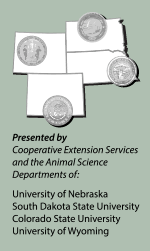Capturing Value
There is economic value in managing genetics.
by Kasey Brown, associate editor, Angus Journal
RAPID CITY, S.D. (Dec. 4, 2013) — We all know there is value in genetic management, but how do we effectively capture its value? Lisa Elliott, commodity marketing specialist from South Dakota State University, asked this question to more than 500 attendees of the 23rd Range Beef Cow Symposium in Rapid City, S.D., Dec. 3-5, 2013.

Strategic alliances help in market differentiation, said Lisa Elliott, commodity marketing specialist from South Dakota State University.
Organizational design and market differentiation help capture that value more fully. The organizational design of the beef industry is segmented, and she noted that there are benefits to vertical integration. It can reduce transaction and potential bureaucratic costs. While vertical integration is far from likely for the beef industry, more information and feedback between segments would help capture the value of genetic management.
“This information flow depends on records and performance information being shared through the supply chain, either through efficient, clear price signals, or from information and value-sharing in more integrated supply chains,” Elliott said.
Strategic alliances help in market differentiation. She placed the benefits of these kinds of alliances between vertical integration and the spot market. For instance, alliances can get bulk input purchases; reduce transaction costs, like commission and trucking fees; increase information sharing like management, carcass and performance data; and get more value-based pricing for products, like grid pricing formulas. Most notably, the Certified Angus Beef® (CAB®) brand and U.S. Premium Beef (USPB) are examples of these alliances.
She noted there is potential for more of these types of alliances in the Northern Plains because of more feedlots moving north, higher technology adoption rates, higher cattle quality, larger operation size and more readily kept records.
Less region-specific, she gave her recommendations for capturing added value through genetic management.
- Improve genetic protocols and provide transparency.
- Be creative; there are many possibilities for strategic alliances, including proper feedback mechanisms.
- Identify producers with whom to partner who have similar operation and genetic management techniques.
- Market differentiation that is clear and transparent.
- Identify new, efficient, organizational arrangements and market-differentiation mechanisms that are complementary to greater genetic management.
- Identify genetic-management technologies that need to be developed to capture more value.
Elliott spoke Wednesday at RBCS XXIII. Visit the Newsroom at www.rangebeefcow.com/2013 to view her PowerPoint, read her proceedings paper or listen to her presentation.
---------------------
The RBCS is a biennial educational symposium offering practical production management information. It is sponsored by the Cooperative Extension Service and animal science departments of the University of Wyoming, South Dakota State University, Colorado State University and the University of Nebraska.
Comprehensive coverage of the symposium is available online at www.rangebeefcow.com. Compiled by the Angus Journal editorial team, the site is made possible through sponsorship of LiveAuctions.tv and the cooperation of the host committee.
Editor’s Note: This article was written under contract or by staff of the Angus Journal. To request reprint permission and guidelines, contact Shauna Rose Hermel, editor, at 816-383-5270.


